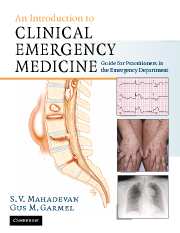Book contents
- Frontmatter
- Contents
- List of contributors
- Foreword
- Acknowledgments
- Dedication
- Section 1 Principles of Emergency Medicine
- Section 2 Primary Complaints
- 9 Abdominal pain
- 10 Abnormal behavior
- 11 Allergic reactions and anaphylactic syndromes
- 12 Altered mental status
- 13 Chest pain
- 14 Constipation
- 15 Crying and irritability
- 16 Diabetes-related emergencies
- 17 Diarrhea
- 18 Dizziness and vertigo
- 19 Ear pain, nosebleed and throat pain (ENT)
- 20 Extremity trauma
- 21 Eye pain, redness and visual loss
- 22 Fever in adults
- 23 Fever in children
- 24 Gastrointestinal bleeding
- 25 Headache
- 26 Hypertensive urgencies and emergencies
- 27 Joint pain
- 28 Low back pain
- 29 Pelvic pain
- 30 Rash
- 31 Scrotal pain
- 32 Seizures
- 33 Shortness of breath in adults
- 34 Shortness of breath in children
- 35 Syncope
- 36 Toxicologic emergencies
- 37 Urinary-related complaints
- 38 Vaginal bleeding
- 39 Vomiting
- 40 Weakness
- Section 3 Unique Issues in Emergency Medicine
- Section 4 Appendices
- Index
40 - Weakness
Published online by Cambridge University Press: 27 October 2009
- Frontmatter
- Contents
- List of contributors
- Foreword
- Acknowledgments
- Dedication
- Section 1 Principles of Emergency Medicine
- Section 2 Primary Complaints
- 9 Abdominal pain
- 10 Abnormal behavior
- 11 Allergic reactions and anaphylactic syndromes
- 12 Altered mental status
- 13 Chest pain
- 14 Constipation
- 15 Crying and irritability
- 16 Diabetes-related emergencies
- 17 Diarrhea
- 18 Dizziness and vertigo
- 19 Ear pain, nosebleed and throat pain (ENT)
- 20 Extremity trauma
- 21 Eye pain, redness and visual loss
- 22 Fever in adults
- 23 Fever in children
- 24 Gastrointestinal bleeding
- 25 Headache
- 26 Hypertensive urgencies and emergencies
- 27 Joint pain
- 28 Low back pain
- 29 Pelvic pain
- 30 Rash
- 31 Scrotal pain
- 32 Seizures
- 33 Shortness of breath in adults
- 34 Shortness of breath in children
- 35 Syncope
- 36 Toxicologic emergencies
- 37 Urinary-related complaints
- 38 Vaginal bleeding
- 39 Vomiting
- 40 Weakness
- Section 3 Unique Issues in Emergency Medicine
- Section 4 Appendices
- Index
Summary
Scope of the problem
On almost a daily basis, emergency physicians encounter at least one patient with the chief complaint of “weakness.” In contrast to most other presentations, the true meaning of the patient's complaint may sometimes be difficult to ascertain. What symptoms are the patient and/or his or her family trying to convey?
On the one hand, the patient may be complaining of a sensation of global lack of energy, extreme fatigue, lightheadedness, or simply feeling “ill.” In this regard, the differential diagnosis extends from fairly benign etiologies (mild dehydration, viral syndrome, hypothyroidism, mild depression) to life-threatening emergencies requiring immediate intervention (acute myocardial infarction (AMI), sepsis, pericardial effusion with tamponade). Other clues may be present to help make the correct diagnosis, but the isolated complaint of “weakness” may be associated with any of these pathologies in isolation or combination, or a myriad of other possible etiologies.
On the other hand, the patient may present complaining of a specific distribution of weakness associated with a true impairment of motor function. Patients with the chief complaint of motor weakness present in a number of different ways. They may present with hemiparesis (weakness of one side of the body without complete paralysis) or hemiplegia (complete paralysis of one side of the body) indicating probable vascular occlusion in a cervicocerebral arterial distribution and ongoing ischemic stroke or transient ischemic attack (TIA).
- Type
- Chapter
- Information
- An Introduction to Clinical Emergency MedicineGuide for Practitioners in the Emergency Department, pp. 581 - 604Publisher: Cambridge University PressPrint publication year: 2005



